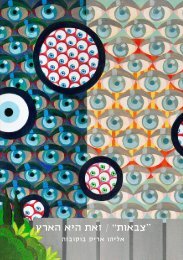eliahou eric bokobza ×ר×ק ××××× ××ק×××× eliya tsuchida ×××ת ××ר
eliahou eric bokobza ×ר×ק ××××× ××ק×××× eliya tsuchida ×××ת ××ר
eliahou eric bokobza ×ר×ק ××××× ××ק×××× eliya tsuchida ×××ת ××ר
You also want an ePaper? Increase the reach of your titles
YUMPU automatically turns print PDFs into web optimized ePapers that Google loves.
Ayelet Zohar<br />
The Obi Series<br />
Wallpaper collage on plywood panels<br />
2012<br />
The Obi series ( 帯 - おび) addresses issues of camouflage and invisibility, detection and<br />
misidentification, aiming and shooting, jointly inquiring questions of patterning and<br />
disappearance.<br />
The series title, Obi (the Kimono’s sash), is taken from the traditional Japanese dress and<br />
dress-sense that employs complex composition and harmony between varying elements: the<br />
Kimono, the Obi (the kimono’s sash), zori sandals and the binding strings. Kimonos worn by<br />
young women are usually vibrant and abundant in colours and patterns, those contain flowery<br />
bright shades and abstract patterning, side by side. As a result, matching a Kimono and an<br />
Obi requires skill, sophistication and a intricate sense of aesthetics in order to attain a<br />
perfect fit between the two. A lady’s creativity and aesthetic sense is often judged by her<br />
ability to create non-conventional juxtapositions of the two.<br />
This strategy is employed in achieving camouflage and invisibility: in painting, subjects<br />
tend to be presented in isolation, or set against fair background which does not challenge<br />
their dominance. Camouflage, on the other hand, is a process of blending and concealment –<br />
whence the subject is assimilated into its surroundings by repetition of shapes, shades,<br />
shadows and abstract patterns. Creating visual camouflage is an analytical process and<br />
precise identification of colour codes, patterning, object presence and shading existing in<br />
a given space, then repeating it as reconstructed shapes onto the surface of the concealed<br />
object.<br />
Wallpapers are the raw material of this series: they have accidently crossed my attention<br />
while thrown away as discarded materials from San Francisco’s best interior designers’<br />
houses. For months I have accumulated hundreds of wallpaper styles, considering the<br />
different categorization methods I could use. But after crystallising my initial concept of<br />
the Sniper and the Obi, I sorted the different patterns according to background colour and<br />
the way these patterns combine into systems of mergence and camouflage.<br />
Different thinkers have considered the questions of Mimicry and Camouflage beyond the<br />
survival need as this topic appeared in Darwinian thoughts on biology, or even in military<br />
studies. Philosophers have mainly considered how this form of disappearance and absence<br />
from the gaze of the viewer, may affect the existence of the camouflaged subject: Roger<br />
Caillois suggested to view mimicry and resemblance of insects to their environment as an<br />
act that expresses a Pantheist desire to merge into Nature; Jacques Lacan, basing his theory<br />
on Caillois’ thought, relates to the Gaze between the subject and the object and the screen<br />
(of camouflage) located between them; Gilles Deleuze and Felix Guattari see the position of<br />
one as disappearing into the human ‘landscape’ as ‘everyone’ as the goal of the process of<br />
Becoming; and finally, Paul Virilio in his discussion of war and architecture, believes that<br />
camouflage is a practice employed through a broader strategy of deceit and invisibility,<br />
crucial performances in warfare.<br />
Continuing with this thread of thinking, the group of images presented in Ani-Ma, the Sniper<br />
became my central theme, and it appears in several works. The sniper is a lone soldier,<br />
himself hidden and concealed from its target by location as well as the usage of materials<br />
taken from the place where the sniper hides. acting with competent preciseness. He is the<br />
perfect paradigm of the relationship between the subject and its background, gaze and<br />
invisibility in relation to the different thoughts expressed above: his body is concealed<br />
by the camouflage patterns printed onto his garment, or the Ghillie Suit, his gaze controls<br />
space, while the power of his weapon holds the possibility to delete life with a small pull<br />
of the trigger. The sniper is a cross-point between patterning aesthetics and camouflage<br />
practices, between the matching of the Kimono and the Obi and the colourful presence of the<br />
tableau structures as a wallpaper collage.<br />
19






